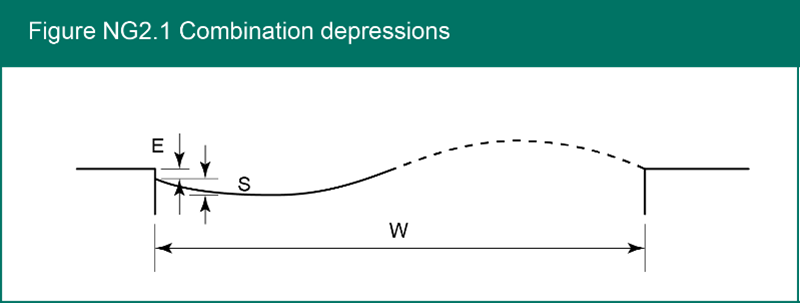Edge depression
Pedestrians and two wheeled vehicles are particularly sensitive to edge depressions. Given that both modes use or cross roads, footways and cycle tracks, a single limit for all edge depressions is appropriate.
Surface depression
Excessive surface depressions reduce ride quality and give rise to noise and vibration. The maximum depth of surface depression within the area of a reinstatement is limited to approximately 2.5% of the width of reinstatement, which represents a mean slope of 1 in 20 (5% gradient). To prevent excessive areas of standing water, the maximum depth of a surface depression is limited to 25 mm regardless of the reinstatement width.
Surface crowning
Excessive surface crowning will reduce ride quality and give rise to noise and vibration. The maximum height of crowning within the area of a reinstatement is limited to approximately 2.5% of the width of the reinstatement, which represents a mean slope of 1 in 20 (5% gradient). To prevent excessive surface irregularity, the maximum height of crowning is limited to 25 mm regardless of the reinstatement width.
Combined defect
The intervention limits for surface depressions and surface crowning include a reduction in the intervention limit to 80% of the tabulated value, subject to a minimum of 10 mm, where surface depressions and/or crowning and/or edge depressions abut. The individual features must be measured, and the reduction applied, as follows:
- Combination depressions
Where an edge depression abuts an area of surface depression, the area of abutting depression should be measured as shown in Figure NG2.1. Any surface crowning abutting an area of combined depressions should be measured separately, as shown in Figure NG2.2. The permitted depth of a combined depression is further limited if the depression results in standing water.

E is the edge depression contribution and S is the surface depression contribution. Once E and S are measured, they are compared with the combined defect intervention limits set in Table S2.1. If E or S is greater than the specified limit, intervention is needed. - Combination crowning
Where an area of surface crowning abuts an edge depression, a surface depression or any combination thereof, then the area of abutting crowning should be measured as shown in Figure NG2.2. The area of abutting depression should be measured separately, as shown in Figure NG2.1. The height of combination crowning should be reduced if it results in standing water.

C is the Surface crowning contribution. If this value is greater than the combined defect intervention limit specified in Table S2.2, intervention is needed.
